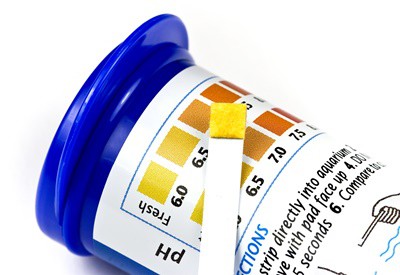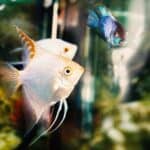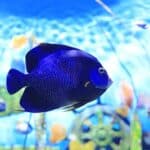When it comes to maintaining optimum tank conditions, alkalinity is often overlooked. The problem is it has a significant impact on the health of fish. If it’s not at the right level, problems will arise.
Low alkalinity causes the pH to plummet, putting your fish under extreme stress. It’ll also cause ammonia to rise to toxic levels, poisoning the fish.
High alkalinity is just as bad as it dissolves the protective mucus layer covering fish, leaving them vulnerable to burns and bacterial infections. It also causes them to lose control over their swim bladders.
Total alkalinity should be tested monthly to ensure it’s suitable for the fish and biofiltration. If you experience frequent changes, check the aquarium weekly until levels stabilize.
What Is Alkalinity in Fish Tanks?
Science for a Changing World describes how alkalinity is the capacity of the water to resist acidification. The water can neutralize acids and maintain a stable pH level.
It’s not a chemical in the water but a property of water that depends on certain chemicals, including hydroxides, carbonates, and bicarbonates.
Alkalinity tells you how much bicarbonate is available in the water.
Alkalinity is more essential in reef aquariums because corals depend on bicarbonate for survival. It acts as a protective barrier that surrounds the pH.
The tank naturally creates acids that eat away at the KH instead of affecting your pH.
It’s not permanent – once the barrier’s gone, the pH moves around freely. A high KH is better, as it neutralizes more acid before it affects the tank’s pH.
It’s invisible, so the only way you’ll know if it’s there is by testing the water.
Fish do best when their environment’s as close to wild conditions as possible, ensuring the alkalinity doesn’t go too high or low.
Either can cause problems, depending on the species and health of the fish.
What’s the Difference Between pH and Alkalinity?
When it comes to water quality, alkalinity is more important than pH.
That’s because it tells you the buffering capacity of water, which is how well the water can resist a change in pH. In comparison, pH tells you whether the water is acidic, neutral, or basic.
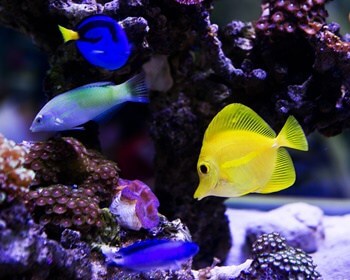
Are KH and Alkalinity the Same Thing?
KH stands for the carbonate hardness in the fish tank. It’s the same thing as alkalinity – the names are used interchangeably. It’s also known as:
- Carbonate hardness.
- Temporary hardness.
- Total alkalinity.
- Buffering capacity/buffer.
- Acid-neutralizing capacity (ANC).
Can Low Alkalinity Kill Fish?
Once alkalinity is depleted, the water’s pH plummets, affecting the tank’s biofilter function and causing extreme stress or death to the fish.
The symptoms of stress in fish include:
- Excessive hiding.
- Glass surfing.
- Changes to their appearance.
- Fin rot.
- Constant sickness.
- Reduced appetite.
Another issue with low alkalinity is ammonia. If the tank experiences a consistently low pH, ammonia will build up because of the lack of alkalinity.
When you replace the water (which should happen at least once a month, if not twice a week), the ammonia turns toxic.
Ammonia poisoning causes your fish to suffer from:
- Red or cloudy eyes.
- Burns, turning the areas around the gills red.
- Lethargy.
- Loss of appetite.
- Breathing difficulties.
Over time, the ammonia will kill the fish.
What Does Low Alkalinity in a Fish Tank Mean?
Low alkalinity indicates a problem somewhere within your tank. It doesn’t need to be a significant issue to affect conditions, but if you leave it to worsen, your fish will undoubtedly suffer.
Low alkalinity is caused by:
- Water changes.
- Decreased aeration.
- Driftwood, which softens the water.
- Added CO2.
- High nitrites.
- Pollutants and waste.
- Using a water purifier.
One of these factors is likely to blame, so consider whether you’ve added something to your tank or done something differently when cleaning it.
If so, you must address and fix the issue to protect the fish.
Can High Alkalinity Kill Fish?
Fish are good at tolerating relatively high alkalinity levels. That said, high alkalinity is just as deadly.
If there’s too much alkalinity in your fish tank and it remains that way for an extended period, it can dissolve the protective layer of mucus that covers fish.
This leaves them vulnerable to infections and bacterial-related health conditions. Other symptoms include eye damage, thickening of the skin and gills, and fish gasping.
It also causes fish to lose control over their swim bladders, preventing them from swimming correctly.
The symptoms of swim bladder disease include:
- Poor buoyancy.
- A distended belly.
- Loss of appetite.
- Inability to feed.
- Lethargy.
- Stress.
Young fish are more sensitive to high alkalinity levels than adult fish. If the water’s pH is too extreme, fish and fish eggs in the tank won’t hatch.
Why Is the Alkalinity High in My Fish Tank?
High levels indicate that something’s not quite right within your fish tank. Frustratingly, several things are potentially responsible, including:
- Crushed coral substrate or ornaments.
- Calcium-rich materials, such as limestone.
- Hard water.
- Aquatic plants that trap CO2 and nitrites.
- An ineffective or old filter.
- Fish waste and other organic materials.
As you can see, it isn’t easy to know what’s causing your tank’s elevated alkalinity levels without investigation and testing.
One of the most likely reasons for a high alkalinity level is tap water.
If it’s not at the same alkalinity levels as the water in your tank, you’re at risk of raising them, making them harmful to fish. You must treat tap water before adding it to your aquarium.
In most cases, you can leave it to sit for 24 hours to allow the chemicals to evaporate.
You can also boil it, aerate it, or use a reverse osmosis unit (RO) to dissolve the solids contributing to the pH levels. Doing this will protect the fish.
What Should the Alkalinity Be In a Fish Tank?
All fish have different alkalinity requirements, but some popular fish, like cichlids, gouramis, and tetras, need slightly alkaline water. Freshwater fish like these need a pH ranging from 6.8 to 7.8.
If it increases more than this, they’re at risk of stress, shock, and death. If they survive the change in pH, they’ll become aggressive and more prone to diseases. The water should also be:
- Well-aerated.
- Low in dissolved mineral salts.
- Warm.
This is why you must routinely test your fish tank’s water to ensure the alkalinity levels remain stable.
How Do I Fix the Alkalinity in a Fish Tank?
Before fixing the alkalinity in your tank, you need to know:
- The current pH levels.
- The pH level that’s best for the fish.
To keep the fish healthy, address any issues as they arise. Failing to do so leads to death.
Getting the right pH level in your tank is critical, but it may change occasionally. While this isn’t unusual, you need to know how to get it back to safe levels.
Here’s how you can both increase and decrease them:
Lower the Alkalinity
If the alkalinity is too high, you’ll need to reduce it. You can do this in the following ways:
Reverse Osmosis
Reverse osmosis removes 99% of dissolved solids, including chlorine and chloramine. It also draws water hardness and regulates the water’s pH.
Reverse osmosis allows owners to create the best conditions for tropical and cold-water fish.
It does this by forcing water through a semipermeable membrane covered in tiny holes, allowing water to pass but stopping contaminants.
The contaminants are then drained out of the system, while the purified water is sent to a water storage unit to be used in your tank.
Remember, this process is likely to remove essential minerals from the tank, but you can remineralize the water before adding fish to it.
Peat Moss
Peat moss as your substrate can help reduce the water’s alkalinity and pH. Peat moss filters out contaminants, so you can also add it to your filter inside a mesh or muslin bag.
Choose pure peat moss containing no artificial additives and use small amounts, gradually increasing it so that the alkalinity doesn’t suddenly drop.
Increase Carbon Dioxide
Low carbon dioxide levels are associated with high pH and alkalinity.
Increase the CO2 in your tank by reducing aeration or adding additional carbon dioxide. A liquid fertilizer or CO2 gas infusor kit can achieve this goal.
Don’t add too much because it’ll increase oxygen demand, affecting your fish.
Add Driftwood
As mentioned, driftwood softens the water and effectively lowers the tank’s alkalinity.
Get two or three pieces from an aquarium store and start by placing one of them into the bottom of the tank. The wood’s natural humic and tannic acid should help to reduce the alkalinity.
If you’re still experiencing high alkalinity levels after a week, add another piece and keep testing the water until the alkalinity is at an acceptable level. Driftwood has other benefits, as it gives fish places to hide.
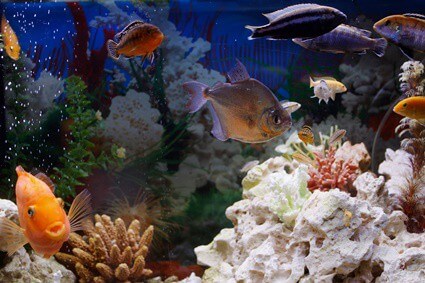
Increase the Alkalinity
You might find that your alkalinity is too low. If so, you’ll need to increase it to provide a better environment for your fish. Here’s how:
Water Change
Carrying out frequent water changes can correct your water’s alkalinity levels. If you don’t do this, the chemical balance will swing too far one way, causing problems for your fish.
Don’t change all of the water at one time, or you’ll risk removing the beneficial bacteria that have established themselves within the tank. Follow this schedule long-term:
- If you have a powerful filter or very few fish, change the water once a month.
- Change about 30% at a time once every two weeks.
- Change 15-20% at a time once a week.
- Change 5-10% at a time twice a week.
This should keep your tank’s alkalinity levels stable.
Change Substrate
As described, specific substrates naturally raise the alkalinity of your tank.
Limestone, seashells, and crushed coral are the main culprits, so you could try replacing your current substrate with one of these instead.
However, you must add them gradually, as you can’t control how they impact the pH and alkalinity levels. If you add them too fast, you risk raising the levels too much the other way.
Increase Aeration
Increasing aeration in your tank raises oxygen levels, naturally reducing the carbon dioxide in the aquarium. This will naturally raise both the alkalinity and the pH.
You can increase the oxygen with the following devices:
- Surface bubbler: Releases streams of bubbles and oxygen.
- HOB filter: Hangs on the back of the tank and releases water into the aquarium at the surface.
- Powerhead: Creates more water flow.
- Wavemaker: Makes waves that agitate the water’s surface.
- Spray bars and sprinklers: Add water to the aquarium.
You only need one, but any will increase the oxygen levels.
Use Baking Soda
Baking soda is a common and effective method of increasing the tank’s alkalinity levels.
To do so, dissolve one teaspoon of baking soda in water for every 5 gallons in the tank (some say 10 gallons, but this might be too much for some tanks).
After adding it to the tank, wait 24 hours and check the alkalinity levels to see whether they’ve changed.
Getting the right alkalinity balance is tricky, but you must regularly test the water to ensure the levels don’t become unbalanced too much or too frequently.

